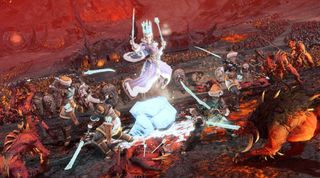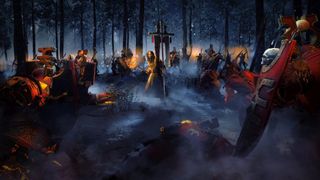Warhammer's Kislev army protects the world from Chaos with lots and lots of bears
The bear necessities.
Many mortal races would have you believe that they single handedly hold back the endless tide of Chaos. And, in the case of Kislev, that might actually be true.
Kislev is the most northerly civilised nation in the Old World, and the bulwark against the dark forces which occupy the Northern Wastes. Without them, Chaos-worshipping tribes and countless monstrosities would have free passage into the Empire. In that respect, Kislev is like the bouncer manning the door to civilisation—but instead of turning away lads wearing trainers, they violently repel anything with tentacles.
Because of this, Kislevites are stern, unflinching people. They brook no dissent or subterfuge. Its Tsars and Tsarinas rule with icy, totalitarian will because they have to: one loose brick and the Kislevite wall that protects humanity will come crumbling down. Every member of society, from lowly farmers to bear-riding boyars, is ready to take up arms against the Ruinous Powers. Even nature itself rebels against the malign influence of Chaos, with snow leopards and giant elemental bears roaring into battle alongside Kislev’s forces.

We've partnered up with Sega to create The Tome of Knowledge, a series of articles and videos that showcase the flavour, personality and units of Total War: Warhammer 3's factions.
Faith binds Kislev together. Its cults and religions are united under The Great Orthodoxy, founded by Tzar Boris Bokha. This is a centralised, unifying religious movement intended to codify the Kislevite faith. The Cults dedicated to Kislev's gods remain active, but only with the oversight of the Orthodoxy. Chief among these is the Cult of Ursun, the Great Bear and patron god of Kislev. And at the head of the Ursunite Cult is Supreme Patriarch Kostaltyn—a wild-eyed and wailing demagogue whose zealotry makes him impossible to kill.
Unlike the Empire, Kislev doesn’t have colleges of magic. Its sorcery instead comes from the Ice Court—a group of powerful Ice Witches within the Royal Palace that acts as a separate political body, and more. Here, the noble daughters of Kislev prepared for a life of conflict and command. Those yet to complete their training are known as Frost Maidens. Eventually they’ll become Ice Witches, able to harness the raw, murderous power of the cold as a weapon.
On the battlefield, Kislev is a versatile army built to withstand dark forces. It boasts elite cavalry units, resolute infantry, and enough bears to populate an endless number of violent picnics. Boyars and Ice Witches lead the forces, the latter with a selection of vicious spells that can freeze the ground beneath an enemy’s feel and encase allies within protective barriers.
Kossars are the foundation of Kislev’s army—grizzled fighters, most of whom are the same foresters and trappers who supply the nation’s great cities. Their traditional weapons, the bow and the axe, symbolise the hunter and the woodsman respectively. They’re lightly armoured, cheap to recruit, and, like all Kislevites, hold their nerve in all but the most dire circumstances.
The biggest gaming news, reviews and hardware deals
Keep up to date with the most important stories and the best deals, as picked by the PC Gamer team.

Kislev’s versatility is reflected in its hybrid units: Streltsi come equipped with rifles that double up as greataxes, capable of finishing off any units who actually reach them, reminding us there’s something lovely about a gun that’s dangerous at both ends. And Ice Maidens are the elite warriors of the Ice Court who can slow opponents with magic-imbued bows and even specialise to take on monstrous units.
The Oblast, a bleak wilderness where a sturdy steed is literally the difference between life and death, makes up most of Kislev. And that’s perhaps why Kislev is famous for its mounted units. Winged Lancers and The Gryphon Legion are the sort of horsemen that would even give a Bretonnian self-esteem issues. And War Bear riders can back up their fearsome charge with increased longevity in the melee. Because they’re literally riding bears.
Kislev isn’t known for its artillery, and, in fact, Kislevite nobles were expressly forbidden from maintaining cannons in the past. During the reign of Tzar Alexis a dozen new guns were commissioned, but, over time, most have been lost. The few that remain do pack an impressive punch, and, as you might expect, they also come equipped with bears—enough to discourage all but the most dedicated skirmishers. And if that’s not enough bears—and it’s not, because there’s no such thing—the army is also capable of fielding Elemental Bears: colossal, magical creatures that represent nature at its most brutal and unrelenting, able to smash down enemy gates and even hold their own against the Greater Daemons of Chaos.
It’s a force that embodies Kislev’s grim, unyielding refusal to crumble in the face of isolation, atrocious climate, and the worst next-door-neighbours the Warhammer world has to offer. If you want an army that doesn’t just laugh at hardship so much as charge directly at it on a 1000lb apex predator, then Kislev has a saddled bear with your name on it.
Most Popular


